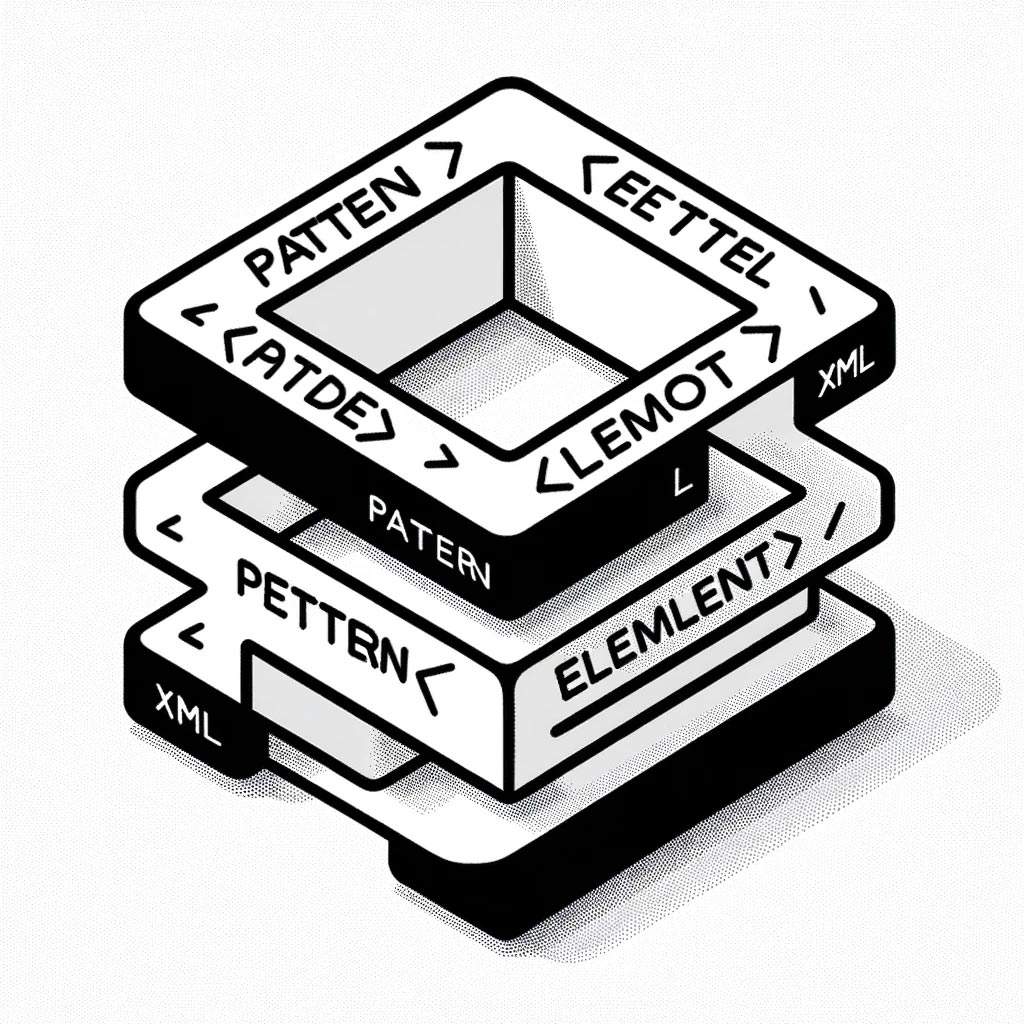What is a design pattern?
A design pattern is a design pattern for software as an abstract description. In programming, design patterns are usually object-oriented code drafts.
Design patterns as a general solution for the design of software
A design pattern is a general, repeatable solution for a frequently occurring problem in software design. It is not a specific piece of code, but rather a template or blueprint that can be used in different situations to solve similar problems.

Design Pattern -Frameworks for Software Design
Best practices for software developers
Design patterns provide a common vocabulary and a set of best practices for software developers to communicate and collaborate effectively. They encapsulate the knowledge and experience of experienced software engineers and enable developers to create high-quality, maintainable and expandable software systems.
Design patterns, structural patterns and behavioral patterns
Design patterns can be divided into three categories: Design patterns, structural patterns and behavioral patterns.
Design patterns deal with mechanisms for object creation, whereby an attempt is made to create objects in a way that is suitable for the respective situation.
Structural patterns deal with the composition of objects and the relationships between objects and thus facilitate the design of software architectures. Behavioral patterns focus on communication between objects and facilitate the development of communication mechanisms between the objects in the system.
Examples of design patterns
Examples of design patterns are the Singleton patternwhich ensures that a class has only one instance, the Factory patternpattern, which creates objects without specifying the exact class to be created, and the Observer pattern, which defines a one-to-many dependency between objects so that when an object’s state changes, all its dependents are notified and automatically updated.
Overall, design patterns are a powerful tool for software developers to create high-quality software that is maintainable, extensible and easy to understand.

Book of Design Patterns – Software development
Design patterns solve a class of problems
A single design pattern always represents a solution for a class of problems. On the one hand, this means that a design pattern represents a formally correct and high-quality solution. On the other hand, the problem for which the design pattern offers a (code-based) solution occurs repeatedly and is therefore relevant for many software engineers, programmers, etc.
How can a design pattern be represented?
Design patterns can be mapped in many description languages. These languages use a combination of a natural language, UML-like diagrams, complex mathematical or logic-based formalisms, or eXtensible Markup Language (XML) for the development of software.
Composite design patterns also exist, which are based on a descriptive Design Pattern Description Language (DPDL), for example, as well as supporting a technical representation – via XML, for example.
How do design patterns solve problems?
Design patterns solve problems by providing proven solutions to recurring design problems that occur during the software development process. They encapsulate the knowledge and experience of experienced software engineers and enable developers to create high-quality, maintainable and expandable software systems.
This is how a design pattern solves a problem:
The following section shows some of the ways in which design patterns solve problems:
1. abstraction: Design patterns provide a high level of abstraction that allows developers to focus on the most important design aspects of a system without getting bogged down in implementation details.
2. reusability: design patterns provide reusable solutions to common problems, reducing the time and effort required to design and implement a system.
2. flexibility: design patterns facilitate the modification and extension of a system by providing a set of well-defined interfaces and implementation guidelines.
3. maintainability: Design patterns improve the maintainability of a system by promoting modularity and reducing coupling between components.
4. communication: Design patterns provide a common vocabulary and a set of best practices for developers to communicate and collaborate effectively.
5. performance: Design patterns can improve the performance of a system by providing optimized solutions to common problems.
Overall, design patterns help developers solve problems by providing a set of well-defined, reusable solutions that have been proven in real-world scenarios. They facilitate the development of high-quality, maintainable and expandable software systems that meet the requirements of users and interest groups.
When was Design Pattern created?
The term design pattern was first used in 1977 in an essay by C. Alexander entitled
“A Pattern Language: Towns, Buildings, Construction”
was used.
The term was later incorporated into the book
Design Patterns by Gamma, Helm, Johnson and Vlissides
from 1994.
This standard work of software development shows solutions for a design problem in the paradigm of object-oriented programming. Design patterns show a well thought-out solution to a problem and explain how this solution should be implemented.
How do I create a design pattern?
At the beginning of their book, the Gang of Four – as the authors of the book Design Patterns are nicknamed – emphasize the gamma principles.
How to create a design pattern for your software problem:
The creation of a design pattern requires a deep understanding of software design principles as well as a thorough knowledge of the problem area and the requirements of the system to be designed.
Here are some steps you should follow when creating a design pattern:
1. identify the problem: Start by identifying a recurring problem in software design that you have encountered or observed. The problem should be general enough that it can be applied to several situations.
2. analyze the problem: Analyze the problem in detail and identify the key factors that contribute to the problem. Determine the root cause of the problem and consider the constraints and requirements of the system.
3. propose a solution: Develop a solution to the problem that is general enough to be applied in different situations. The solution should be simple, elegant and effective and take into account the limitations and requirements of the system.
4. refine the solution: Refine your solution by testing it in several situations and refining it based on feedback and experience. Consider edge cases and unusual scenarios to ensure that the solution is robust and reliable.
5. document the design pattern: document the design pattern in detail, including its name, purpose, structure and usage guidelines. Add code examples and diagrams to illustrate how the pattern works in practice.
6. share the design pattern: share the pattern with other developers and ask them for feedback and suggestions for improvement. Consider publishing the pattern in a design pattern catalog or other resource to make it available to a wider audience.
Overall, creating a design pattern requires a deep understanding of software design principles as well as creativity, analytical thinking and attention to detail.
By following these steps, you can create a powerful and effective design pattern that can be used to solve recurring software design problems.
Design pattern recommendations
Principle 1: Use APIs for your design pattern
The first principle states that it is advisable and more reliable to program in the direction of an interface. The developer should program via interfaces and not directly with the object in question.
After all, the developer should only be concerned with the communication with the object – what it can send and receive – and not with the object behind it.
Principle 1: Use delegation and enable code reusability
The second principle is the delegation of code, which enables the reuse of code parts. The main object sends a request to a second object – the delegate – which forwards the request to the recipient object. In this process, communication therefore takes place via three actors, one of whom helps the sender.
Finally, the book Design Patterns presents a number of design patterns, because although they are generalized patterns, it is not always necessary or sensible to use one design instead of another.
In addition, the proposed designs are divided into categories:
Creational Pattern – Creative design pattern
A creational pattern makes it possible to optimize the creation of objects.
Creational patterns are a category of design patterns that deal with mechanisms for creating objects. They offer possibilities to create objects in a way that corresponds to the situation and the needs of the system.
The main aim of design patterns is to encapsulate the process of object creation and make it more flexible and decoupled from the rest of the system.
Examples of creative design patterns:
Factory-Method
The factory method pattern provides an interface for creating objects, but allows subclasses to decide which class should be instantiated. It is useful if you want to decouple the creation of objects from the rest of the system and provide a way to create objects of different types without specifying their concrete classes.
Abstract Factory pattern
The Abstract Factory pattern provides an interface for creating families of related or dependent objects without specifying their concrete classes. It is useful if you need to create objects that are related to each other and want to ensure that they are consistent and compatible with each other.
Singleton
The singleton pattern ensures that a class has only one instance and provides a global access point to it. It is useful if you need to ensure that there is only one instance of a class in the system and want to provide a way to access it from anywhere in the system.
Builder
The Builder pattern separates the construction of a complex object from its representation and allows you to create different representations of the same object. It is useful when you need to create objects with many different configurations and options and ensure that they are consistent and easy to use.
Prototype
With the prototype patternyou can create new objects by cloning existing objects instead of creating them from scratch. It is useful when you need to create objects that are similar to existing objects but have some differences or variations.
Overall, creation patterns offer powerful and flexible ways to create objects in a way that suits the situation and the requirements of the system.
By using these patterns, you can improve the flexibility, decoupling and maintainability of your software systems.
Structural Pattern – design pattern for structuring software components
A structural pattern makes it possible to increase the functionality of objects without changing their composition.
What are structural patterns?
Structure patterns are a category of design patterns that deal with the composition of classes and objects into larger structures. They focus on how classes and objects can be combined to form more complex structures and provide a set of guidelines to achieve the desired structure.
Examples of structural design patterns:
Adapter
You can use the adapter pattern to adapt the interface of an existing class to the interface of a customer requirement. It is useful if you have an existing class that does not match the customer’s interface, but you cannot change the existing class.
Bridge
The bridge pattern decouples an abstraction from your implementation and allows you to vary independently. It is useful if you have multiple implementations of an abstraction and want to decouple them from the abstraction to allow more flexibility and extensibility.
Composite
The composite pattern allows you to treat a group of objects as a single object and provide a uniform interface to them. It is useful if you have a group of objects that need to be treated as a single object and to which you want to apply operations in a uniform way.
Decorator
The Decorator pattern allows you to dynamically add new behavior to an object without changing its class. It is useful if you have an object that needs to be extended with new functions, but whose class you cannot change directly.
Facade
The Facade pattern provides a simplified interface to a complex system and hides the complexity of the system from the clients. It is useful if you have a complex system that is difficult to use or understand and you want to provide a simpler interface for it.
Overall, structure patterns provide a set ofguidelines for combining classes and objects into larger structures in order to achieve the desired functionality and maintainability of a system.
By using these patterns, you can improve the flexibility, decoupling and expandability of your software systems.
Behavioral patterns
A behavioral pattern takes into account the way in which the classes communicate with each other.
Behavioral patternsare a category of design patterns that deal with the communication and interaction between classes and objects. They focus on how objects work together and communicate with each other to achieve certain behaviors or functions.
Examples of behavior-oriented design patterns:
Observer
With the Observer pattern, you can define a one-to-many dependency between objectsso that all dependent objects are automatically notified and updated when the status of an object changes. It is useful if you have a group of objects that need to be notified when a change occurs in another object.
Strategy pattern
The Strategy pattern allows you to define a family of interchangeable algorithms or behaviors and encapsulate them in separate classes. It is useful if you have several algorithms that can be used interchangeably and you want to encapsulate each algorithm in a separate class.
Template method
The template method pattern defines the skeleton of an algorithm in a base class and allows subclassesto overwrite certain steps of the algorithm without changing its structure. It is useful if you have a process that can be broken down into specific steps and you want to allow subclasses to customize some of these steps without changing the overall structure of the process.
Command pattern
The command pattern encapsulates a request as an object and allows you to parameterize clients with different requests, queue or log requests and support undoable operations. It is useful if you need to separate the request for an action from the execution of the action itself and want to provide a way to queue, log or undo these requests.
Iterator
The iterator pattern provides a way to sequentially access the elements of an aggregate object without revealing the underlying representation. It is useful if you have a collection of objects that need to be accessed sequentially and you want to hide the underlying representation of the collection.
Overall, behavior patterns provide a set of guidelines for how objects work together and communicate with each other to achieve certain behaviors or functions.
By using these patterns, you can improve the flexibility, maintainability and expandability of your software systems.
Summary – Why you should definitely use design patterns actively:
Design patterns are reusable solutions for common software design problems. They provide a set of guidelines and best practices for structuring and organizing code to achieve certain functionalities and maintainability.
By using design patterns, developers can avoid common pitfalls and create maintainable, flexible and expandable software systems.
Three main categories of design patterns:
There are three categories of different design patterns: creative, structural and behavioral. Design patterns deal with the creation of objects, structure patterns with the composition of objects and behavior patterns with the interaction of objects.
Advantages of using design patterns
The use of design patterns can offer several advantages, including
Reusability
Design patterns are reusable solutions to common problems, which can save developers time and effort.
Maintainability
Design patterns promote good programming practices, such as decoupling and separation of concerns, which can make code maintenance easier.
Flexibility
Design patterns can make code more flexible and adaptable by providing a clear structure for adding new or changing existing functionality.
Expandability
Design patterns can increase the extensibility of code by providing a clear structure for adding new functions or behaviors without interfering with existing code.
Overall, design patterns provide a structured approach to software design and can help developers create more maintainable, flexible and extensible software systems.
By understanding and using design patterns, developers can improve the quality and effectiveness of their code and avoid common software design pitfalls.
From a developer’s perspective, the customization of design patterns will bring you and all teams significant benefits in terms of maintainability, reusability and extensibility of the code.
By using established patterns, you as a software developer can leverage the collective experience of the software development community to solve common problems more effectively and efficiently.
This allows you to create more robust and reliable software systemsthat are easier to maintain and expand over time.
In addition, the use of design patterns can help developers to write more modular and better organized code, which will automatically lead to less complexity and better overall quality.
Ultimately, the active use of design patterns helps to make software development more effective and efficient and to create higher quality software products.



